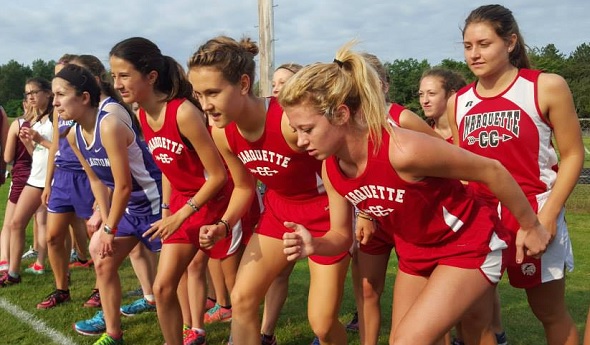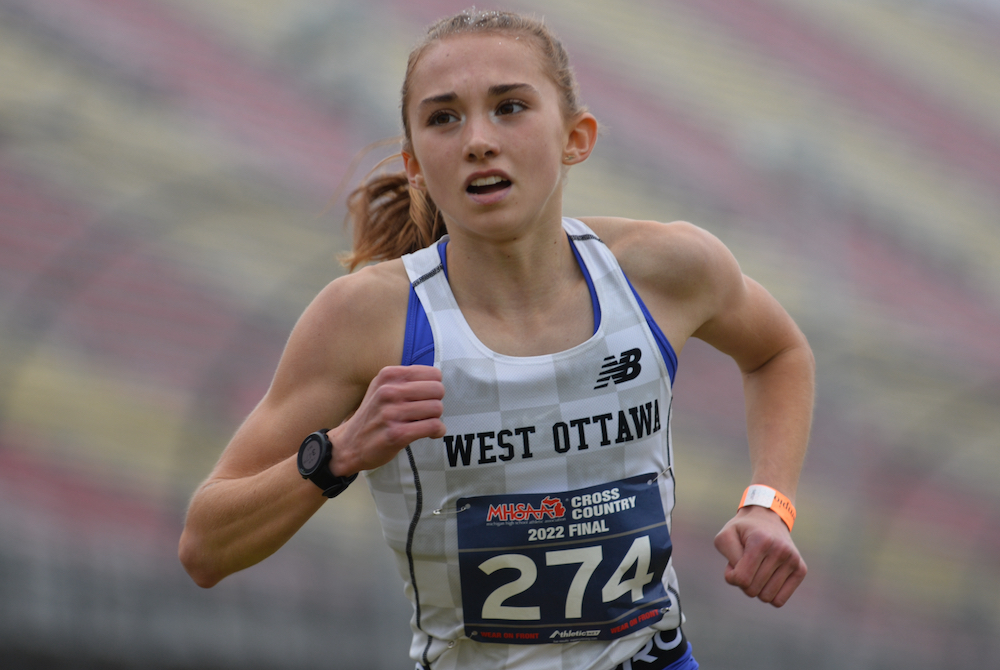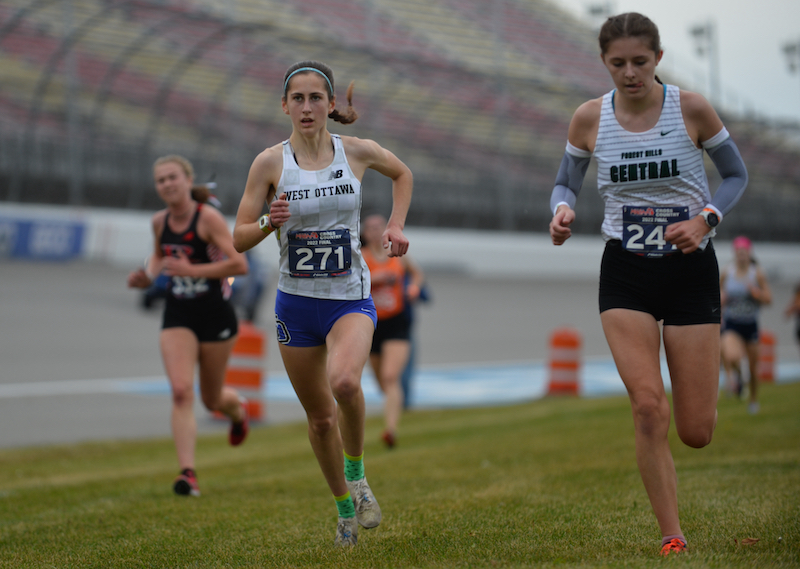
Marquette Primed to Continue Dynasty
October 21, 2015
By Dennis Grall
Special for Second Half
MARQUETTE – Red is the dominant color when you talk about cross country in Michigan's Upper Peninsula.
Courtesy of one of the pre-eminent cross country programs in the state, red is worn by the Marquette High School teams that have been a scourge to the rest of the U.P. since the sport's inception.
 The boys have won 22 Upper Peninsula big-school championships heading into Saturday's U.P. Finals at Beauchamp's Grove in Flat Rock, in the countryside west of Escanaba. The boys have been competing since 1966, and Marquette began its title string in 1979.
The boys have won 22 Upper Peninsula big-school championships heading into Saturday's U.P. Finals at Beauchamp's Grove in Flat Rock, in the countryside west of Escanaba. The boys have been competing since 1966, and Marquette began its title string in 1979.
The girls have been even more dominant, claiming 29 U.P. titles since the sport began in 1980, including a string of 13 straight (1980-92).
Both teams have won the past two U.P. Division 1 titles and are expected to repeat again Saturday.
All of the championships have come with Dale Phillips as head coach. Phillips, 73, started coaching both teams in 1977. He was inducted into the Upper Peninsula Sports Hall of Fame in 2009 for his coaching exploits with Marquette's cross country and track and field programs.
Asked what has kept him running the program for 39 years, Phillips did not hesitate. "My love working with the program and the young men and young women and seeing the success they can achieve," he said, noting he is coaching a second generation of runners and enjoys visiting the parents of today's athletes, many of whom he coached.
"They are a great recruiting tool," he said of parents bringing their kids into the program.
Phillips traces the program's success to when it started piling up those various trophies. "Then we started drawing boys and girls into it. They like what we do," he said. "The program kept building. It is like the Menominee football program. It seems they re-load every year, just like we do.
"You are going to hit a down period. There were some lean years," said Phillips. Of course, those "lean years" meant settling for second, third or fourth place.
"Sometimes you just don't get that quality you need. You just get kids into the program and they really work."
This year's leaders are Lance Rambo for the boys and Lindsey Rudden for the girls. Rambo is looking into running at either Central Michigan University, Michigan State or Grand Valley State after graduation. Rudden, who has never won a U.P. cross country title but owns eight U.P. track championships (with MHSAA meet records in the 800, 1,600 and 3,200 and with the 1,600 and 3,200 relay units), has verbally committed to run for MSU.
But it is not about super individuals. Rather, it is about the overall depth of the program and the family-like atmosphere. "The varsity cheers for the jayvee group, and the jayvees cheer for their varsity teammates. They know they are a total team. It is not just the top seven we are interested in," Phillips said.
 "You don't have to be the number one or two runner," Phillips tells his squads. "You can be number five, six or seven. You can help us immensely by getting ahead of the scorers of our opponents."
"You don't have to be the number one or two runner," Phillips tells his squads. "You can be number five, six or seven. You can help us immensely by getting ahead of the scorers of our opponents."
To illustrate, at the recent Great Northern Conference meet at Marquette's Presque Isle (complete with a water spout on Lake Superior, tornado warning, lightning, thunder and rain), the first nine girls jayvee finishers wore Marquette red. Marquette's boys and girls swept the varsity and junior varsity team titles.
"We emphasize that we are a team. The kids get so close as a team," Phillips said of the runners gathering for a variety of activities such as meals, movies and swimming. "We are a family. That word has come up for years."
Of course, a lot of that likely comes from the success they have all enjoyed together throughout their careers and from watching their predecessors do the same thing.
Agreeing that success breeds success, Phillips said, "that is a tremendous positive we have going for us. We have a large freshman class out and they learn how we do our workouts correctly and how we handle pace (of racing). We have some talent coming up."
The Redmen set such a tremendously high bar of success without piling up excessive mileage. "We try to get them to reach their peak at the end of the season," said Phillips.
While every coach tries to accomplish that goal, there is a fine line to reach in the process – no matter the sport or the level the athlete is playing.
"Leadership on a team is important," said Phillips, noting he sends groups of runners out at various distances and locations and tries to match them up with those of similar skill sets. With captains such as Rambo and Rudden setting the pace this year, Phillips knows the workouts will be fruitful. "Those kids lead by example. They keep the young runners going. They have responded well over the years," he said.
The coaching staff sets mileage limits and tries to monitor how much the athletes do on their spare time. "We are not a high mileage team," said Phillips. "We try to get a recovery day after a tough workout or a tough meet. We structure our program to keep the legs fresh and minimize injuries."
The runners do just 30-40 miles a week, much of it on an exquisite city trail system or at a grassy park close to nearby Northern Michigan University. "If we do a hard workout, we try to find a soft surface," said Phillips. "We can do hard workouts but they are not hard on the legs."
 Including pre-and-post stretching sessions, the weekday workouts last two hours a day in August before classes begin and no more than 90 minutes a day once the academic season starts. "We do longer intervals before the start of the season and shorter intervals later," he said, adding runners are told not to run on one of the weekend days.
Including pre-and-post stretching sessions, the weekday workouts last two hours a day in August before classes begin and no more than 90 minutes a day once the academic season starts. "We do longer intervals before the start of the season and shorter intervals later," he said, adding runners are told not to run on one of the weekend days.
Having quality runners throughout the group prevents varsity runners from becoming complacent. "Our jayvees keep the varsity on their toes," Phillips said.
He also encourages his runners to use alternative sports in their training to keep their legs fresh. "If you don't feel like running, jump on a bike. Biking is an excellent cross-trainer. They also go cross country skiing. You shouldn't run 365 days a year," he said.
"If you're in a winter sport, you can't get in better shape than running in cross country," said Phillips, noting several of Marquette's highly successful winter athletes have been on his teams. "That has been a drawing card as well" to attract participation.
In his 39 years at the helm, Phillips said a major highlight was when the girls won the prestigious Holly Invitational and the boys were 10th out of 30 teams in 1982. It was the first time the Redettes and Redmen participated, and many of the downstate runners were surprised to learn Marquette came from the Upper Peninsula.
The girls finished second, fifth, seventh, ninth and 11th and beat Clio, ranked No. 1 in the state at the time. "They couldn't believe someone from the U.P. could come down and dominate a big meet," said Phillips.
Competing in Holly, and big meets in Wisconsin, gives his runners a chance to see "other faces and other teams" and a chance to gauge their performances. That is especially important because cross country (in addition to track and field, tennis, golf, and swimming and diving) is split into Upper Peninsula and Lower Peninsula Finals.
While Phillips and former U.P. cross country coaches John Prokos, Dave Lahtinen and Arne Henderson previously made a strong push to merge for an all-peninsula MHSAA Finals, they were unable to convince the majority of U.P. teams to accept the proposal, which has been rejected twice.
In the meantime, Marquette makes everyone else look at red across the Upper Peninsula.
 Denny Grall retired in 2012 after 39 years at the Escanaba Daily Press and four at the Green Bay Press-Gazette, plus 15 months for WLST radio in Escanaba; he served as the Daily Press sports editor from 1970-80 and again from 1984-2012. Grall was inducted into the Upper Peninsula Sports Hall of Fame in 2002 and serves as its executive secretary. E-mail him at [email protected] with story ideas for the Upper Peninsula.
Denny Grall retired in 2012 after 39 years at the Escanaba Daily Press and four at the Green Bay Press-Gazette, plus 15 months for WLST radio in Escanaba; he served as the Daily Press sports editor from 1970-80 and again from 1984-2012. Grall was inducted into the Upper Peninsula Sports Hall of Fame in 2002 and serves as its executive secretary. E-mail him at [email protected] with story ideas for the Upper Peninsula.
PHOTOS: (Top) Marquette’s girls cross country runners, including Lindsey Rudden, front right, prepare for the start at Marquette’s cross country relays earlier this season. (Middle) A pair of Marquette runners including Lance Rambo, right, compete during the boys race. (Below) Coach Dale Phillips has led the program for 39 years. (Photos courtesy of Marquette athletic department.)

Sachs Surges from Start to Lead Holland West Ottawa to LPD1 Finals Sweep
November 5, 2022
BROOKLYN – Helen Sachs of Holland West Ottawa doesn’t run alone in many cross country meets, which is unusual for an elite runner.
The best runners have to learn to race solo, because there will be meets in which they can simply overwhelm the competition.
But there is always at least one worthy competitor nearby when Sachs races. She runs on the same team as senior Arianne Olson, herself one of the top contenders at the MHSAA Lower Peninsula Division 1 Final on Saturday at Michigan International Speedway.
So, Sachs was surprised to find herself already alone at the front just 200 meters into the race. She never allowed the pack to catch up, winning by 24.73 seconds with a time of 17:18.74.
“I saw nobody in front of me except for the start when they all went off,” said Sachs, a sophomore. “I was just in front. I was like someone is gonna be coming up behind me, because I know the state meet is when people just go for it. No one came up with me.
“It was kind of weird. I was looking forward to some competition or people to run with. It was still fun to run in such a big race, though. It was cool.”
 Sachs won eight of her 10 races this season, placing second in the other two to Olson. Olson, who was third in Division 1 last season, placed ninth this time in 18:27.13.
Sachs won eight of her 10 races this season, placing second in the other two to Olson. Olson, who was third in Division 1 last season, placed ninth this time in 18:27.13.
That powerful 1-2 punch up front allowed West Ottawa to win the team championship in dominant fashion, 97-172 over runner-up Romeo.
The Panthers placed their five scoring runners in the top 50, while every other contending team had at least one scoring runner place in the 100s.
Training daily with such a powerful team helped Sachs become an MHSAA champion.
“I just picked up on the dedication, getting everything in,” she said. “Our coaches this year focused more on recovery, like running easy, focusing on recovery, which has helped the mindset of everyone on the team.”
Sachs was a ready-made contributor to the West Ottawa program, finishing fifth in Division 1 last season. But even after finishing among the state’s elite a year ago, she didn’t believe she could win an MHSAA individual championship until she started winning big races early this year.
“It’s surreal,” she said. “Last year I was fifth. This year, winning the state championship was crazy. It doesn’t feel real.”
Rounding out the West Ottawa scorers were 38th-place senior Megan Postma, 49th-place sophomore Jane Olney and 50th-place freshman Ava Porras. Grandville senior Allison Arnsman was the individual runner-up in 17:43.47.
PHOTOS (Top) Holland West Ottawa’s Helen Sachs closes in on the finish and her first MHSAA Finals championship. (Middle) West Ottawa’s Arianne Olson and Grand Rapids Forest Hills Central’s Clara James-Heer lead another pack down the stretch. (Click for more from Dave McCauley/RunMichigan.com.)

